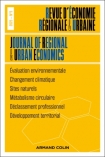
REVUE D'ÉCONOMIE RÉGIONALE ET URBAINE (2/2025)
Pour acheter ce numéro, contactez-nous
Recevez les numéros de l'année en cours et accédez à l'intégralité des articles en ligne.
Cette étude présente une mesure du degré d’internationalisation d’un territoire à partir des indicateurs de connexions proposés par l’Organisation de coopération et de développement économiques (OCDE). Cette dernière propose quatre piliers de l’internationalisation : les humains, les affaires, l’infrastructure et la connaissance. L’analyse de l’internationalisation se concentre sur les petites économies insulaires en développement (PEID) couvrant trois zones géographiques, à savoir l’Afrique, l’Asie-Pacifique et les Caraïbes. En utilisant les démarches de calcul d’indice composite préconisées par l’OCDE (2008) et la méthode de pondération « Analyse par enveloppement de données » (DEA) de Zhou et al. (2007), les résultats nous ont permis de vérifier trois hypothèses. Le degré d’internationalisation relativement faible des PEID (1) avec une hétérogénéité selon le statut d’indépendance (2) et la zone géographique (3). Les PEID devraient d’ailleurs se focaliser sur les connexions humaines et les connexions d’infrastructure.
This study presents an evaluation framework to measure the territory’s degree of internationalization. The aim here is to construct a composite index of internationalization. To calculate this composite index, we rely on the connection indicators proposed by the Organisation for Economic Co-operation and Development (OECD). The latter proposes to analyze the internationalization of a territory on the basis of four dimensions : human connections, business connections, infrastructure connections and knowledge connections. The analysis of internationalization focuses on small open economies, especially small island developing states (SIDS). The island territories covered by this article represent three geographical areas : Africa, Asia-Pacific and Caribbean. Using the composite index calculation approaches recommended by the OECD (2008) and the « Data Envelopment Analysis- Benefit of the Doubt» (DEA-BoD) weighting method (Zhou et al. 2007), three key conclusions are drawn from our analysis. Firstly, most SIDS have a relatively low degree of internationalization, with marked heterogeneity between them and within each geographical area. This suggests that while some island are well integreted in global value chains, many face notable challenges. Secondly, affiliated islands have more difficulties than independent islands. This indicates that the political and economic history plays an important role in the internationalization of these island territories. Thirdly, the internationalization strategies of SIDS should focus on the fundamental axes of infrastructure and human connections. Indeed, emphasizing these two pillars helps overcome natural obstacles to internationalization, such as geographical remoteness and the small size of the economy. In conclusion, our composite index provides a valuable tool for comparing the degree of internationalization accross SIDS and highlights critical strategic priorites.
